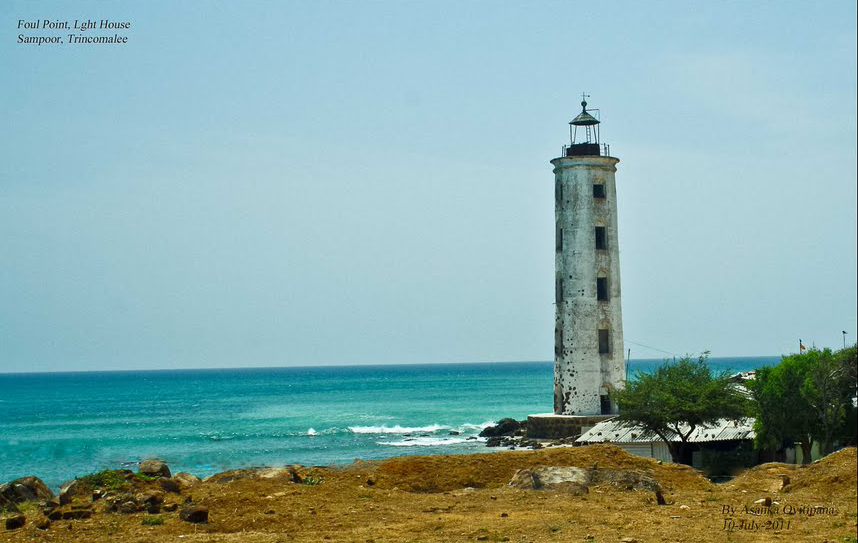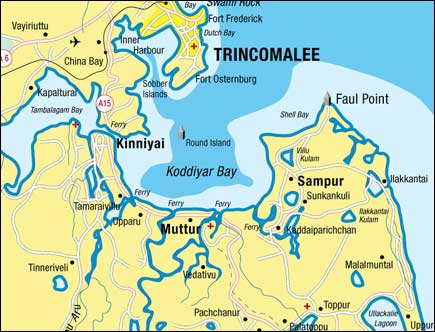Liberating Champoor is liberating Tamils from permanent subjugation in Trincomalee district, say the Tamil people of Moothoor East in Trincomalee. From the average Tamil families languishing in the camps to experts among Tamils coming from Moothoor East, having in-depth knowledge of their region and the politics, are unanimous in their opinion that both the Indian Coal Power Plant, for which lands are allocated 7-8 kilometres close to the residential area in Champoor and the so-called Special Economic Zone where the Sinhala rulers in Colombo are aiming for Sinhala colonisation and the SL military which is going to clear more lands close to the coastal strip for maintaining its military cantonment are going to be the main challenges of the future existence of Tamils in Moothoor East.
SL Prime Minister Ranil Wickramasinghe visited Champoor on Friday, but he avoided to visit the uprooted people at Ki’liveddi, the largest camp of uprooted Eezham Tamils in Moothoor East.
TamilNet interviewed on Friday two uprooted Tamil mothers at Ki’liveddi camp, 48-year-old Nimalathevy Krishnaraj and Chithiraleka Jeeva and the chairman of Champoor Cooperative Society and the president of the welfare society of the Ki’liveddi camp Mr Mylvaganam Krishnapillay and an expert from Moothoor East, on the situation of resettlement.
The families languishing at the camps questioned the motive of the new regime in Colombo. They have been counting the days of the 100-day programme after electing the new regime. The new regime has failed to address their plight on the ground while attempting to depict a different picture to the outside world, they said.
“The previous government of Mahinda Rajapaksa demolished everything to the ground. They wanted to project that these lands are jungle tracts that are being cleared for ‘development’. But, people from Champoor were firm in their stand. For almost 10 years, they were struggling with a resolve to resettle in their own lands. With the help of the informed Tamil diaspora, the struggle to liberate Champoor will be taken forward and the global community will be kept informed,” the Tamil expert, who did not wish to be named, told TamilNet on Friday. The audio interview is published in full.

The expert was of the opinion that Tamils should resist both the so-called industrial zone being propagated by the new regime in Colombo and the Coal Power Plant being promoted by India.
Moothoor East region is one of the most productive agricultural areas in the district with access to potable water, fertile lands and the possibility of water supplies to cultivation from 70 different tanks. “Imagine the potentiality for agriculture and livestock if the Mahaweli water flowing into Koddiyaarak-kudaa is diverted to Moothoor East,” he said. The real sustainable development for Tamils in Moothoor East is in agriculture, livestock and in fishing with related minor industries,” he added.
Northeast monsoon will carry the pollution from the proposed coal power plant into the island a long way and it is not advisable to have such a plant in Trincomalee he said.
Hambantota is perhaps well suited for the installation of the coal power plant as the dust will be taken towards the ocean by the monsoon winds, he said.
 The people of Moothoor would resist, deploying all their efforts in countering the establishment of the coal power plant and the planned industrial zone in the name of so-called economic development. “This is a political programme, not a development programme taking the environmental issues into consideration,” he said. The Tamil-speaking people, both the Muslims and the Tamils, will join hands in the struggle against the occupation programme, he added.
The people of Moothoor would resist, deploying all their efforts in countering the establishment of the coal power plant and the planned industrial zone in the name of so-called economic development. “This is a political programme, not a development programme taking the environmental issues into consideration,” he said. The Tamil-speaking people, both the Muslims and the Tamils, will join hands in the struggle against the occupation programme, he added.
However, Mr Sampanthan, who is also from Trincomalee, is backing the establishment of the Indian coal power plant. He says China would enter the region if Tamils opposed the Indian project. This is absurd, he said.
India, which armed the Tamil movements, abandoned the Tamils after it gained foothold in Trincomalee following the Indo-Lanka Accord of 1987. India got everything while Tamils didn’t gain anything, he added.
The Sinhala colonisation will be taking new forms in the district, he said.
“If you look at the demographic pattern of the district, Muslim people mostly live in Ki’n’niyaa and Moothoor, Tamils live in Trincomalee Town and Gravets and in Moothoor East. Sinhalese have systematically occupied the Seruwila division with largest [area of residential and agricultural] lands since 50s and 60s.”
Tamils, who are largest among the population in the district, have lost their lands. They possess the smallest area of lands. The Muslims, who are next in terms of the population, have more lands than the Tamils. But, Sinhalese, who are the smallest in population in the district, have the largest area of lands in Trincomalee.
The proposed economic zone, industrial park and coal power plant attached to them is a blueprint for Sinhala colonisation, he said.
In the beginning, the SL officials would say the local population would be given first priority in the employment in the proposed industrial zone. But, what would happen in practice is that Tamils would only be given cleaning jobs and other minor employment citing the lack of ‘skilled labourers’. This is what happened at Thampala-kaamam, the Tamil expert said.
The challenge, the Tamils are facing now is three-fold: geopolitical manoeuvring by the external powers, Colombo’s colonization scheme through the so-called ‘economic’ zone and the continued militarization of Moothoor East, especially the coastal strip.
In the meantime, Sri Lankan officials have been demanding original land documents from the uprooted people. The people have handed over photocopies of their documents to the SL authorities.
Even after providing necessary documentation, the people are being told that they would only get their residential lands or alternative lands and a minor portion of their agricultural lands.
The SL government officials are trying to deceive the people with accepting new documents with the promise of resettlement, the representatives of the uprooted Tamils said.
Indian Prime Minister Narendra Modi came to Trincomalee, but he didn’t visit the uprooted people to witness their plight at the camp. Sri Lankan Prime Minister Ranil Wickramasinghe came today to Champoor. He too didn’t visit the uprooted people, the representatives of uprooted complained.
Sinhala and Tamil interests are at loggerhead at Champoor. The global powers are upholding the Sinhala militarization of Champoor. A new phase of the struggle for liberating Champoor has just started, is the opinion prevailing among the Tamils of Moorthoor East.
 Eelamurasu Australia Online News Portal
Eelamurasu Australia Online News Portal
